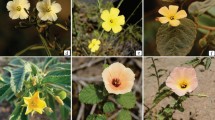Abstract
The Mediterranean distylousLinum suffruticosum has dimorphic pollen. That from short-styled plants has sub-monomorphic surface excrescences with minute papillae; that from long-styled plants has strongly dimorphic excrescences with conspicuous papillae. The differences are much like those described in species of other sections of the genus. Pollen of the related homostylousL. tenuifolium has monomorphic pollen. It combines characteristics of bothL. suffruticosum types but resembles that of the long-styled plants somewhat more closely. Ribbonlike styles of long-styled plants ofL. suffruticosum provide another feature which seems to be controlled by the S supergene thought to be associated with distylic incompatibility. The pollen ofL. suffruticosum andL. tenuifolium is very similar to that of some species of sectionLinastrum and would support their placement in that section.
Similar content being viewed by others
References
Dulberger, R., 1973: Distyly inLinum pubescens andL. mucronatum.—Bot. J. Linn. Soc.66, 117–126.
, 1974: Structural dimorphism of stigmatic papillae in distylousLinum species. — Amer. J. Bot.61, 238–243.
, 1975: S-gene action and the significance of characters in the heterostylous syndrome. — Heredity35, 407–415.
Heitz, B., Jean, R., Prensir, G., 1971: Observation de la surface du stigmate et des grains de pollen deLinum austriacum L., hétérostyle. — C. R. Hebd. Séances Acad. Sci., Ser. D, Sci. Nat.273, 2493–2495.
Laibach, F., 1921: Über Heterostylie beiLinum. — Z. Indukt. Abstamm.-u. Vererbungslehre27, 245–247.
Lewis, D., 1943: The physiology of incompatibility in plants. II.Linum grandiflorum. — Ann. Bot. (II)7, 115–122.
, 1949: Incompatibility in flowering plants. — Biol. Rev.24, 472–496.
, 1954: Comparative incompatibility in angiosperms and fungi. — Adv. Genet.6, 235–285.
Ockendon, D. J., 1968: Biosystematic studies in theLinum perenne group.—New Phytol.67, 787–813.
, 1968:Linaceae. InTutin & al. (Eds.): Flora Europaea2, 206–211. — Cambridge: Univ. Press.
Saad, I., 1961: Pollen morphology and sporoderm stratification inLinum. — Grana Palynolog.3, 109–129.
Ubisch, G. von, 1925: Genetisch-physiologische Analyse der Heterostylie. — Bibliogr. Genet.2, 287–342.
Vuilleumier, B. S., 1967: The origin and evolutionary development of heterostyly in angiosperms. — Evol.21, 210–226.
Author information
Authors and Affiliations
Rights and permissions
About this article
Cite this article
Rogers, C.M. Distyly and pollen dimorphism inLinum suffruticosum (Linaceae). Pl Syst Evol 131, 127–132 (1979). https://doi.org/10.1007/BF00984126
Received:
Issue Date:
DOI: https://doi.org/10.1007/BF00984126



